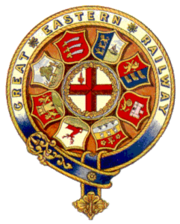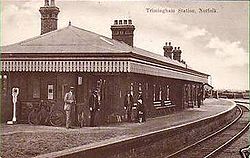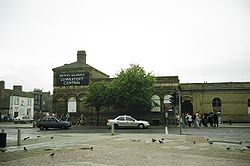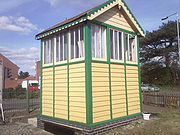
Norfolk and Suffolk Joint Railway
Encyclopedia

Joint railway
A joint railway is a railway operating under the control of more than one railway company: those companies very often supplying the traction over the railway.-United Kingdom:There are many examples of joint railway working in the United Kingdom...
company.
The NSJR was owned by the Great Eastern Railway
Great Eastern Railway
The Great Eastern Railway was a pre-grouping British railway company, whose main line linked London Liverpool Street to Norwich and which had other lines through East Anglia...
(GER) and the Midland and Great Northern Joint Railway
Midland and Great Northern Joint Railway
The Midland and Great Northern Joint Railway, was a joint railway owned by the Midland Railway and the Great Northern Railway in eastern England, affectionately known as the 'Muddle and Get Nowhere' to generations of passengers, enthusiasts, and other users.The main line ran from Peterborough to...
(MGNJ) and consisted of two distinct sections: a line between North Walsham
North Walsham
North Walsham is a market town and civil parish in Norfolk, England in the North Norfolk district.-Demographics:The civil parish has an area of and in the 2001 census had a population of 11,998. For the purposes of local government, the parish falls within the district of North...
and Cromer
Cromer
Cromer is a coastal town and civil parish in north Norfolk, England. The local government authority is North Norfolk District Council, whose headquarters is in Holt Road in the town. The town is situated 23 miles north of the county town, Norwich, and is 4 miles east of Sheringham...
via Mundesley
Mundesley
Mundesley is a coastal village and a civil parish in the English county of Norfolk. The village is 20.3 miles north-north east of Norwich, 7.3 miles south east of Cromer and 136 miles north east of London. The village lies 5.6 miles north-north east of the town of North Walsham. The nearest...
, and a coastal section running from Gorleston
Gorleston
Gorleston-On-Sea, also known colloquially as Gorleston, is a settlement in Norfolk in the United Kingdom, forming part of the larger town of Great Yarmouth. Situated at the mouth of the River Yare it was a port town at the time of the Domesday Book. The port then became a centre of fishing for...
to Lowestoft
Lowestoft
Lowestoft is a town in the English county of Suffolk. The town is on the North Sea coast and is the most easterly point of the United Kingdom. It is north-east of London, north-east of Ipswich and south-east of Norwich...
. Neither has survived apart from a 1.5 miles (2.4 km) stretch just south of Cromer which forms part of today’s Bittern Line
Bittern Line
The Bittern Line is a railway line from Norwich to Cromer then Sheringham in Norfolk, England. It is one of the most scenic in the East of England traversing the Norfolk Broads on its route to the Area of Outstanding Natural Beauty on the North Norfolk Coast. The line is part of the Network Rail...
.
Whilst the GER was a constituent company of the London and North Eastern Railway
London and North Eastern Railway
The London and North Eastern Railway was the second-largest of the "Big Four" railway companies created by the Railways Act 1921 in Britain...
(LNER), the MGNJ interest became jointly held by the LNER and London, Midland and Scottish Railway
London, Midland and Scottish Railway
The London Midland and Scottish Railway was a British railway company. It was formed on 1 January 1923 under the Railways Act of 1921, which required the grouping of over 120 separate railway companies into just four...
(LMS), and the railway retained its identity at the 1923 Grouping
Railways Act 1921
The Railways Act 1921, also known as the Grouping Act, was an enactment by the British government of David Lloyd George intended to stem the losses being made by many of the country's 120 railway companies, move the railways away from internal competition, and to retain some of the benefits which...
; in the Third Schedule of the Transport Act 1947, the LNER, LMS, MGNJ and NSJR are all listed among the bodies whose undertakings are to be transferred to the British Transport Commission on 1 January 1948, it thus became part of British Rail
British Rail
British Railways , which from 1965 traded as British Rail, was the operator of most of the rail transport in Great Britain between 1948 and 1997. It was formed from the nationalisation of the "Big Four" British railway companies and lasted until the gradual privatisation of British Rail, in stages...
ways.
The North Walsham to Cromer section
The section between Cromer and North Walsham is easy to follow on aerial photographs, and some sections remain open as unofficial footpaths.Leaving Cromer Beach, a short section of formation remains in use as part of the Bittern Line
Bittern Line
The Bittern Line is a railway line from Norwich to Cromer then Sheringham in Norfolk, England. It is one of the most scenic in the East of England traversing the Norfolk Broads on its route to the Area of Outstanding Natural Beauty on the North Norfolk Coast. The line is part of the Network Rail...
. Although the portals of the Cromer Tunnel
Cromer Tunnel
The Cromer Tunnel was built by the Norfolk and Suffolk Joint Railway to take their Cromer Beach to Mundesley line under the Great Eastern's Cromer High to Norwich line...
, the only remaining original railway tunnel in Norfolk, remain open access is difficult due to a housing development on the former trackbed.
The first station on this section of the NSJR was Cromer Links Halt (TG232409) which primarily served golfers at the nearby Royal Cromer Golf Club. The station facilities were very basic, consisting of no more than a single wooden platform, which cost £170 to build, two wooden benches and running-in board together with the obligatory oil lamps. No shelter was provided for passengers and the platform was constructed of sleepers
Railroad tie
A railroad tie/railway tie , or railway sleeper is a rectangular item used to support the rails in railroad tracks...
and supported by wooden trestles.
This was followed by Overstrand railway station
Overstrand railway station
Overstrand railway station was a station in North Norfolk on the Norfolk and Suffolk Joint Railway, serving the settlement of Overstrand. It was much used in the summer months by holidaymakers. It closed along with the rest of the line in April 1953....
, which was provided with an island platform, pedestrian underpass, signal box and passing loop. The station building and underpass remain as a private residence. A section of the embankment towards Cromer was removed to make way for a housing development.
Sidestrand Halt
Sidestrand Halt railway station
Sidestrand Halt was a railway station on the Norfolk and Suffolk Joint Railway which briefly served the Norfolk coastal village of Sidestrand from 1936 to 1953.-History:...
consisted of a simple wooden platform capable of accommodating one coach. Hidden away at the end of a public footpath, the station did not have any ticket-issuing facilities, and these could only be purchased on the trains. The halt had been opened in an attempt to increase revenues on the line by further exploiting the tourist potential of "Poppyland".

Trimingham railway station
Trimingham railway station was a station in Trimingham, Norfolk on the Norfolk and Suffolk Joint Railway line between Cromer Beach and North Walsham. It closed in 1953-External links:*...
was a similar design to Overstrand, although access to the platforms was provided by steps from a gateway on a nearby road overbridge. Although the station site has been redeveloped, the bridge and the closed station access remain.
Mundesley railway station
Mundesley railway station
Mundesley railway station was a former station on the Norfolk and Suffolk Joint Railway in Mundesley, Norfolk. It opened in 1898. In 1953 it became the terminus of the line from North Walsham when the route to Cromer closed. In 1964 the remainder of the route was closed.-References:**-External...
was provided with wide platforms and substantial buildings and a yard for the anticipated holiday traffic. Today nothing remains of the station site, which has been redeveloped as a housing estate.
Paston & Knapton railway station
Paston & Knapton railway station
Paston and Knapton railway station was a station in North Norfolk on the Norfolk and Suffolk Joint Railway line between Cromer Beach and North Walsham. It served the settlements of Paston & Knapton, through it was nearer to the former. It closed on 5 October 1964 to passengers and to goods on 28...
, the final station on this section of the NSJR before reaching North Walsham
North Walsham
North Walsham is a market town and civil parish in Norfolk, England in the North Norfolk district.-Demographics:The civil parish has an area of and in the 2001 census had a population of 11,998. For the purposes of local government, the parish falls within the district of North...
remains in good order as a private house. The trackbed continues to the outskirts of North Walsham, having been used as the route for a gas feeder pipe from the Bacton Gas Terminal
Bacton Gas Terminal
The Bacton Gas Terminal is a large gas terminal found on the North Sea coast in North Norfolk near Paston and between Bacton and Mundesley. The nearest main town is North Walsham. The other main UK gas terminals are at St Fergus, Aberdeenshire and the Easington, East Riding of...
. Once reaching North Walsham the formation has been used to build a bypass
Bypass (road)
A bypass is a road or highway that avoids or "bypasses" a built-up area, town, or village, to let through traffic flow without interference from local traffic, to reduce congestion in the built-up area, and to improve road safety....
, although the trackbed linking the NSJR to the former GER Bittern Line can be still be clearly seen.
North Walsham Town railway station
North Walsham Town railway station
North Walsham Town railway station was a station in North Walsham, Norfolk. It served the now closed Midland and Great Northern Joint Railway lines to Melton Constable via Aylsham, Melton Constable via Mundesley and Sheringham, and Great Yarmouth via Potter Heigham...
, the original M&GNJR terminus for the services, closed to passengers in 1959 and the site is now a gas condensate rail terminal.
The coastal section


On this section, all of the overbridges are intact, some of which still contain relics from their railway heritage
To the north of the town, a large amount of the formation has been redeveloped as a housing estate and, although a section beside the golf course remains clear, the section through the Pleasurewood Hills
Pleasurewood Hills
Pleasurewood Hills is a theme park on a site between Corton and Gunton, near Lowestoft, Suffolk. The park contains attractions including three rollercoasters. Its mascot is called Woody Bear, who was given a "sailor" look in 2007...
theme park has been totally removed.
The site of the former station at is known as "Beeching Drive" with a small pedestrianised area known as "Stephenson's Walk".
Corton station is now a private house, however its canopy and other features are in decay. For several years Corton had a static Camping coach
Camping coach
Camping coaches were offered by many railway companies in the United Kingdom as accommodation for holiday makers in rural or coastal areas.The coaches were old passenger vehicles no longer suitable for use in trains, which were converted to provide basic sleeping and living space at static locations...
in a siding. It was used as accommodation for holiday makers. The line near Corton can be traced fairly easily, including the original embankments.
The line through has been redeveloped for housing. While the line was open, this station was also used as a location for a camping coach.
The next station, was opened in July 1914 to serve the adjacent golf course. The station was closed four years later as a post-war economy measure, but was reopened in 1919, this time as a result of the increasing number of holiday makers visiting the area. Initially named "Gorleston Links Halt", the station was renamed just "Gorleston Links" in 1968, two years before its eventual closure.
The area where the station was situated has changed greatly in the years since 1970; residential redevelopment has led to the removal of the bridge and embankment, leaving no trace of the former halt.
The route of the railway line south of Gorleston Links ran almost parallel with the A12 (Lowestoft Road) to Station Road in Hopton
Hopton-on-Sea
Hopton-on-Sea should not be confused with the village of Hopton which is still in Suffolk but near to the Norfolk town of Diss.There is also a British Holidays Caravan Park, named Hopton Holiday Village. There is also a Hopton near Wirksworth in Derbyshire...
, which was the location of Hopton railway station
Hopton railway station
Hopton-on-Sea was a railway station serving the village of Hopton-on-Sea in Norfolk. It closed in 1970.For several years Hopton had a static Camping coach in a siding...
.
A small section from the line of Gorleston railway station is in use as a walkway, running about half a mile before ending by a road overbridge. The rest of the line is mostly now housing and roads.
The route of the coastal section from Gorleston-on-Sea
Gorleston railway station
Gorleston-on-Sea railway station was a station in Gorleston-on-Sea in Norfolk. It was on the line between Great Yarmouth and Lowestoft which closed in 1970.Gorleston is now one of the larger towns/localities in Britain without a railway station....
northwards to the junction for the line to London is now used by the A12. The original terminus, was also the terminus of the Great Eastern Railway line to Beccles and beyond. After closure. the station was used as the headquarters of an oil company before being demolished in the 1980s to make way for the A12 link road. On the site of the old yards are Homebase, Matalan and Lidl stores.
Details of the coastal section of the N&SJR as part of the a larger network can be found on the page for the Midland and Great Northern Joint Railway
Midland and Great Northern Joint Railway
The Midland and Great Northern Joint Railway, was a joint railway owned by the Midland Railway and the Great Northern Railway in eastern England, affectionately known as the 'Muddle and Get Nowhere' to generations of passengers, enthusiasts, and other users.The main line ran from Peterborough to...
.
Preservation

A Norfolk and Suffolk Joint Railway signal box, formerly at Laundry Lane (now known as Eastern Way) in Lowestoft
Lowestoft
Lowestoft is a town in the English county of Suffolk. The town is on the North Sea coast and is the most easterly point of the United Kingdom. It is north-east of London, north-east of Ipswich and south-east of Norwich...
, has been rebuilt as Dereham North at East Dereham
Dereham railway station
Dereham railway station is a railway station in the town of Dereham in the English county of Norfolk. The station is served by heritage services on the Mid-Norfolk Railway from Dereham to Wymondham.- History :...
on the Mid-Norfolk Railway
Mid-Norfolk Railway
The Mid-Norfolk Railway or MNR is a heritage railway in the English county of Norfolk. Opening as a tourist line in 1997, it is often referred to as a "New Generation" heritage railway....
.

